CAMPAGNA 2017 |
1° SETTIMANA |
2° SETTIMANA |
3° SETTIMANA |
4° SETTIMANA |
5° SETTIMANA |
6° SETTIMANA |
7° SETTIMANA |
8° SETTIMANA |
21 GIUGNO 2017 
Resoconto della giornata di scavo
Generale
Si è conclusa la terza giornata di scavo.
Area 2000
Today we continued to scrape down the sections we were working on yesterday. The section where the possible rock clusters had been seen revealed more naturally occurring iron deposits than the soil around it. This area was photographed, measurements and elevations were taken and a detailed description of the soil was made. This area proved to be rocky and very compacted, requiring the use of a pickaxe. About 12 cm were taken off this layer, nothing was found. The other area with a change in sediment colour was troweled down about 5 cm further. Work will continue on both these areas tomorrow.
Area 3000
In Area 3000 continua la pulizia accurata del settore, con lo scopo di completare lo scavo dei contesti sepolcrali di XV-XVI secolo e mettere in luce i livelli legati alla frequentazione della canonica di XI secolo.
Today we started by wetting the ground again and taking a photo from above to see the differences of soil for potential areas of interest for excavation and took GIS coordinate points. After, we cleaned the site again and removed half an inch of the soil for better context. We split into individual areas for more in-depth soil removal to expose remains and fully excavated a cranium, a mandible, rib bones and a scapula.
Area 5000
Today we cleaned the entirety of section c and found more evidence of the holes that we had found yesterday as well as several others, mostly toward the southern end of the plot with two small holes near the southwest corner as well as a larger hole and another which intersected a hole found during previous excavation last year. There were also a mid-sized hole in the center of the section, a small hole containing rocky clay, with shale in one, in the southeast corner of the plot, and two small holes within four inches of each other near the eastern side. We began excavating some of the holes in the southwestern corner and found rocky clay inconsistent with the surrounding soil, but nothing else of note thus far. We will continue to excavate the holes over the next day or so. One of our group members participated in the GIS lab and assisted in plotting the coordinates of the holes and another member of the group participated in the osteology lab, though he did not handle any material pertaining to area 5000.
Area 6000
La rimozione di US 6032 ha permesso di mettere in luce nuove quelle che sembrano essere nuove situazioni sepolcrali nel settore sud dell'area. Per colore, componenti della matrice e consistenza i nuovi strati si riferiscono con molta probabilità ai riempimenti di almeno cinque fosse in nuda terra. L'indagine dei prossimi giorni permetterà di confutare o verificare tale ipotesi.
Today, we finished clean scraping the area to better visualize the site contexts. Any bone fragments or those found out of context were placed in labeled bags to analyze later. Water was then used to better visualize potential burial features. These were identified by noting the changes in color, consistency, and components of fills, which are used to help distinguish between different contexts. For example, the possible filling of one potential burial feature contained numerous rocks and stones, but the area near this was clean and lacked any stones. By cleaning this area, we were able to visualize the changes in consistency and components between these two areas. This process allowed identification of at least five potential burial features that can be excavated.














